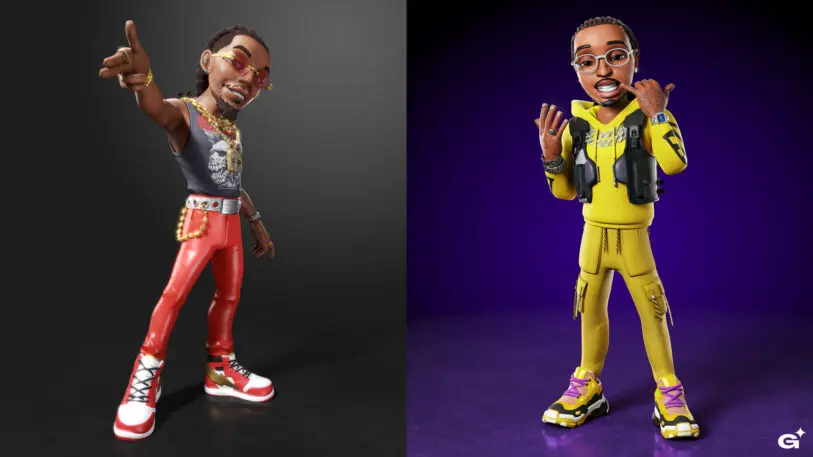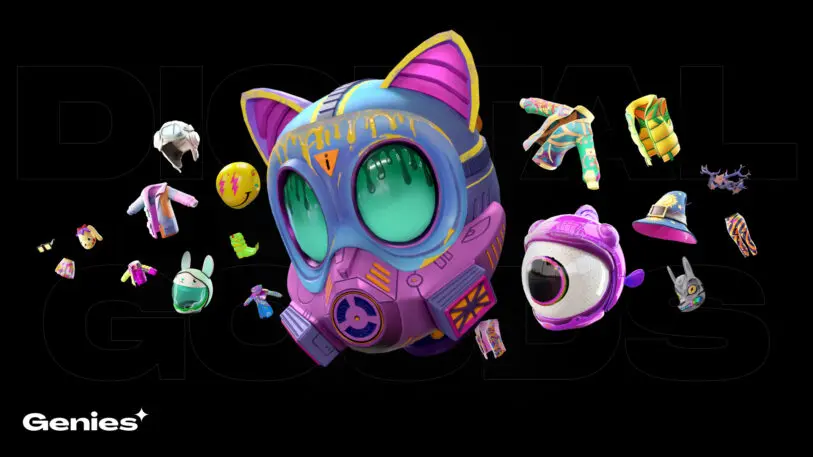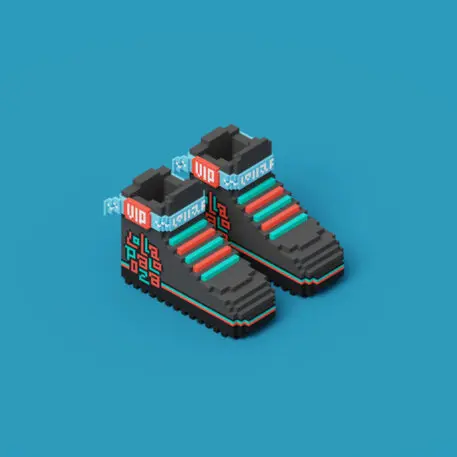Last week, a bunch of digital apes sold at Sotheby’s auction for $24.4 million.
It’s the kind of headline we’re all growing accustomed to in the era of NFTs, or non-fungible tokens that secure an owner’s rights to a digital good or creation. Bored Ape Yacht Club solidified its status as one of the buzziest “NFT clubs,” alongside CrypoPunks and Axie Infinity, where limited-edition avatars are traded for staggering sums. For those who can afford it, changing your avatar on social media in accordance with your latest NFT purchase has become the new digital flex.
But some companies are taking a different approach to swag in the metaverse, giving more utility to digital goods and making them more accessible to everyday users.
Alongside NFTs, conversation around the metaverse has captured the tech world and beyond as the new destination for our digital lives. First coined by author Neal Stephenson in his 1992 novel Snow Crash, the concept of the metaverse first gained prominence with the rise of games such as Fortnite and Roblox but has only exploded as NFTs have come into focus.
The metaverse is ushering in a new wave of commerce and social experiences. The question now is who will you be in it?
A recent study from Squarespace and The Harris Poll found that 60% of Gen Z and 62% of Millennials believe how you present yourself online is more important than how you do so in real life. While traditional social media and websites are still used in the majority, metaverse platforms are increasingly becoming engrained in the mainstream, creating a boom in avatar creations and marketplaces to outfit your digital self.
“There’s a lot of ways to show up on the internet—there will be a lot of different ways to show up in the metaverse,” says Ben Hughes, VP of creative at Squarespace. “As the metaverse continues to grow, it’s a place where you’re totally in control of how you present yourself, at a moment where how you present yourself through digital channels is becoming the most important thing”—not to mention potentially an incredibly lucrative thing.
In August, OpenSea, the premier NFT marketplace, hit $3.4 billion in transaction volume on Ethereum, marking a tenfold increase from July. This is no doubt largely fueled by sales of high-profile collectibles à la Bored Ape Yacht Club and CryptoPunks. Those NFT clubs have clearly etched out a lane for themselves akin to investing and selling in the art world.
While the booming market for these projects has made them out of reach for all but the crypto 1%, there’s certainly room in the metaverse for something a little different, for everyone to have their moment to exhibit a digital flex.
Who are you?
Social media has long been derided as a repository for unattainable standards of status, wealth, and beauty that so often leaves users hopelessly chasing after that cachet, at the expense of who they truly are.
A 2020 study examined self-idealized versus authentic self-expression on social media and found individuals who were more of their true self online reported greater life satisfaction. The study’s authors point out that self-idealization is considered a fundamental part of human nature “because it allows individuals to cultivate a positive self-view and to create positive impressions of themselves in others,” but it also can be “psychologically costly” in that it can create internal conflict.

“If I want to be a fucking rock, I can be a rock. The whole point is that I can be literally anything in this entire world,” says Akash Nigam, founder and CEO of Genies. “Don’t think of yourself like you’re creating a Memoji on Apple—those aren’t avatars, in our opinion. Those are just character tools—it’s just a mask. [Genies] could be a virtual being over time. What would you become?”
Nigam started Genies in 2017 after creating a string of social apps, using his own mental health struggles as a starting point. “I’ve suffered from anxiety and depression my entire life,” Nigam says. “I’ve been looking at ways to optimize different internet behaviors, because I felt more comfortable behind the keyboard.”

“Me suffering from anxiety and depression is one thing. But looking at Gen Z, it’s the most mental-health-aware and anxiety-driven demographic there is,” Nigam says. “They grew up on Instagram. So I do think they are looking to swing the pendulum back to a place of authenticity and a place of security when it comes to freedom of expression on the internet. I think an avatar does exactly that.”

“But we’re not just telling you go make a one-to-one representation of what you look in the real world,” he adds. “We purposely give you assets that are fantastical and not possible in the real world. We give you wings. You can have a tail. You can have furs. We’re allowing somebody to tap into their emotion a bit more and not just create a cartoon of themselves. It’s more so a representation of themselves. And our representation doesn’t need to be limited to humanoid.”
But the question is . . . .
Who are you wearing?
Much of the of the NFT hype stems from the scarcity of digital goods and avatars that often go for a king’s ransom on secondary markets. However, there are companies taking a more democratic approach by allowing users to create and sell their own wares.
Genies partnered with Dapper Labs, the company behind NBA Top Shot, to create Genies Marketplace, a platform powered by Dapper Labs’s Flow blockchain where users can set up shop.
“The blue sky vision for the marketplace is that we cover all of culture’s macro and micro events,” Nigam says. “So macro normally goes through the lens of celebrity moments like Kanye West dropping Donda. But if a 16-year-old girl in Iowa has an inside joke with friends at her local high school, she can create a digital wearable or good and then sell it within the marketplace or gift it to a friend.”
And CryptoKickers is doing the same for the hypebeast set.
Founded by ex-Instagram employees Joey Flynn and Thomas Dimson, CryptoKickers is a platform where users can design, mint, and sell their own NFT sneakers on the Solana blockchain.

For a minting fee that averages between $70 and $80, users have sold shoes for upwards of $300.
“We’re trying to triple down on that,” says Flynn, who is CryptoKickers’ product designer. “What can we provide that allows people to have this great social, creative experience, make amazing things that resonate with them and resonate with the community, and then actually get financial benefit for doing it?”

“The mistake that people make about it is that these new spaces aren’t real,” says Hughes at Squarespace. “That’s what people thought about commerce on the internet in the early days. The internet was good to get information, but you would never buy something there. And of course the last 30 years have proven that terribly wrong. And I think that the same conversation is going to happen with the metaverse.”
What do you do?
Another misconception people have is that digital goods have no utility beyond collectible items. One can certainly debate the necessity of wearing Yeezy’s in the metaverse, but at least they’re wearing them.
“Sometimes people get confused about what do these things actually do,” Flynn says. “And I usually give the analogy of when you’re collecting sneakers, you’re often not wearing the sneakers. They are just purely collectibles. And so in some sense, these CryptoKickers have more utility than an actual shoe in the real world because you can flex them in this metaverse space.”
Jadu AR is pushing the idea of utility even further with, of all things, jetpacks that can be used in augmneted reality, with avatars from MeeBits, Fluf World, and Void: Visitors of Imma Degen.
We built a Jetpack NFT that lets your avatars fly in AR and the Metaverse.
More: https://t.co/MI37rtqtfR
Coming for @MeebitsDAO @FLUF_World @ImmaDegen pic.twitter.com/1JwBu4L5IV
— JADU® (@Jadu_AR) September 7, 2021
“The reason we decided to start with jetpacks was because we wanted to show people how to do a secondary item,” says Asad J. Malik, CEO of Jadu AR. “We’re not doing an avatar collection. We’re not doing a primary item that allows you to kind of form your identity around. What jetpacks do is show the crypto community that the assets they’re currently purchasing can be taken to the next step now.”
[Animation: courtesy of Jadu]Malik also says that by making jetpacks available for a range of avatar collections, it provides “a uniform playing field for all these separate communities,” he says. “These characters are completely different sizes. They exist in completely different worlds. Now all of them are going to be able to use jetpacks.”
Of course, Malik is thinking beyond just jetpacks.
The longterm vision for Jadu is to build an AR world where players own the various items that operate inside that world.
To Malik, connecting and outfitting our digital selves is the perfect playground for finding and claiming a spot in the metaverse.
[Animation: courtesy of Jadu]“It just feels like tech finally has an underground,” he says. “Tech has not had an underground for the last two decades because everything’s been in relation to the big VCs that are tied to the big tech companies.”
To that end, with Facebook’s plan to enter the fray, Malik wants to ensure the metaverse, or at least his corner, doesn’t lose its own swag.
“As a young person trying to build their life’s work, it is depressing to to think that the only outcome is that Facebook will buy you,” Malik says. “I’m happy to finally have the opportunity to work on things where that is not the end outcome. For me the future of the metaverse, I don’t think of Facebook workplace. That’s not a metaverse we’re imagining.”
Recognize your brand’s excellence by applying to this year’s Brands That Matter Awards before the early-rate deadline, May 3.